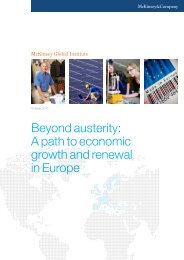Shell energy scenarios to 2050 - Manicore
Shell energy scenarios to 2050 - Manicore
Shell energy scenarios to 2050 - Manicore
Create successful ePaper yourself
Turn your PDF publications into a flip-book with our unique Google optimized e-Paper software.
2.3 The next green revolutionLarge agricultural lobbies are already powerful in developed nations, anda huge push for biofuels develops early in this scenario. This helps meet therapid growth in demand for liquid transport fuels, but also leads <strong>to</strong> unintendedconsequences. First-generation biofuels compete with food production, drivingup world market prices, especially in those countries that use maize as a staple.And regions with insufficient production potential, such as the EU, import theshortfall and so indirectly encourage poorer nations <strong>to</strong> destroy large sections ofrainforests and habitats in order <strong>to</strong> grow palm oil and sugar cane. The result ofthese land use changes is that significant quantities of CO 2s<strong>to</strong>red in the soils arealso released.The reaction <strong>to</strong> these unintended consequences plays its part in helping <strong>to</strong>establish second-generation biofuels by 2020 – those that use the woody partsof plants, including waste products such as stalks and leaves from plants grownfor food production. Certification systems also emerge <strong>to</strong> promote sustainabilityof both first- and second-generation biofuels. A key advantage of secondgenerationbiofuels is that <strong>energy</strong> yields are a lot higher, particularly outside thetropical regions. Most OECD countries, being in temperate regions, encourageand eagerly embrace economic routes <strong>to</strong> second-generation biofuels.18



